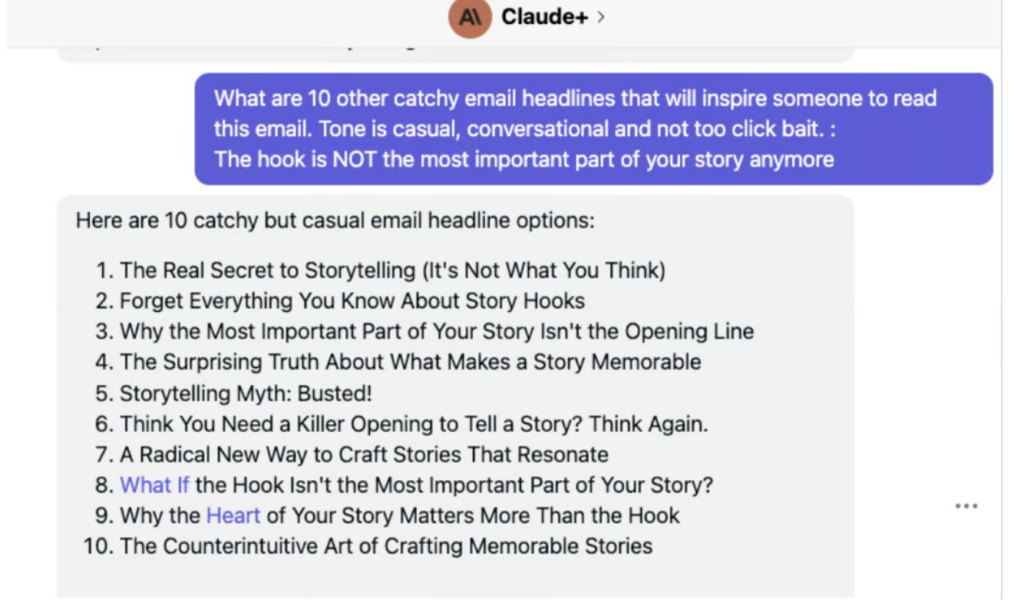I currently live in Brooklyn with my three little boys and husband. What can I say, I’m the unofficial -but official - Queen in my house. I love weird combinations of food (more on that later), going out (MOMS CAN DANCE TOO), and seeing the "A-HA" look on a founder's face when they unleash the story that has been buried in them and their business for way too long.
founder, creative director, and brand storyteller
hi, i'm patrice!
Why the most important part of your story IS NOT your opening line.
Hear me out, because I, too, have said, “the hook is the most important part of your story.”
But I am changing my tune.
Why?
Because of AI and programs like Chat GPT.
My main wingman Claude can vomit out a TON of really awesome Hooks in SECONDS.
Let me show you my original Email headline that I prompted to my friend Claude.

I probably have 28 Instagram posts saved in a black hole of a folder that go like… “AMAZING HOOK PROMPTS THAT YOU CAN USE TOO.”
It is not rocket science to write a compelling hook and we just need to google or AI “give me amazing hook examples” and voila. There they are.
But here’s what AI is NOT great at.
And which also happens to be, in my opinion, THE MOST important part of your story:
Setting up your context.
Setting up your world.
I teach a storytelling formula called the 5Cs. And the first of the Cs is Context.
What does that mean?
At a basic level, context means you are setting up the scene for us.It means that you bring us into YOUR world.
You make us FEEL what you are feeling.
You make us imagine what it would feel like to be you and to walk in your shoes, even if our life looks nothing like yours.
If you start your stories with a KILLER context, you change the brain waves of your viewer or reader.
You all but guarantee your person will stay to the end of your story.
I stumbled upon an old google doc from an online storytelling course I took in 2020.
The exercise was to engage the audience and bring the audience into our world in 250 words.
I choose to focus this exercise prompt on a period in my life in 2016 where I had left the TODAY show for a new media start up. It was supposed to be my dream job.
Here is a portion of what I wrote for this exercise prompt:
“With my breast pump over my shoulder, my laptop bag on the other, I trudged up the stairs of my third floor Brooklyn walk-up hoping the dried stream of (what was now daily) tears and red eyes wouldn’t again be visible to my family upon returning from my new job in Manhattan.
The job which was supposed to be the dream job. The job that supplied the health insurance and financial stability to my family so my husband could finally take the professional risk that he had always dreamed of. The job which pushed me to leave the company I was at only months earlier which by other people’s account WAS the dream job. The job that always just seemed a bit “Off” but then again, it had been six years since I had been at another company, so it was probably me. The job that was slowly chipping away my ability to feel joy in life.”
Here is what Claude wrote to my prompt:

It’s not even a close competition. My context version is so much better.
Why?
Because I bring you into my world as best as I can with details, imagery, and visceral writing.
Even if you are not a breastfeeding mom, my use of words like “trudge” and “lugging” up a 3rd floor walk-up is relatable to anyone.
I set up the stage of anguish by painting the picture of “red eyes” and “dried stream of tears.”
Visceral moments that most humans can relate to.
Even if they cannot relate exactly to the scene I am painting.
Claude. While he did a great job writing, it lacks SOUL.
It lacks FEELING.
And soul and feeling are what makes good stories great.
In my Founder’s Fire program right now I teach my students how to use Chat GPT in the most effective way for their stories.
But it’s a fine balance, because I can always tell when they have outsourced THE ENTIRE story or script to Chat GPT.
And guess what, it’s not as good.
Despite all these amazing AI tools please know this:
YOU are still your best storyteller and marketer.
AI does not have your emotional experiences or personal struggles to draw from and while AI can analyze human emotions, it does not have the capacity for emotional intelligence, empathy and vulnerability that is required to craft compelling stories that create deep emotional resonance.
I’d love for you to reply via comment if you use AI in your storytelling and marketing. How are you using it?